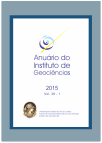Associações de Foraminíferos em Resposta a Variações Ambientais da Laguna de Aveiro -- Portugal
DOI:
https://doi.org/10.11137/2015_2_56_69Keywords:
Spatial and temporal variability, Ecology, Benthic foraminifera, Pollution, Heavy metals, Organic enrichmentAbstract
This study is based on the characterization of the sedimentary environment in selected sites, located in Aveiro canals and salt-pans, in the eastern-central and northern part of Aveiro Lagoon. Results of physicochemical parameters measured in water and sediment, as well as grain size, geochemical and microfaunal (benthic foraminifera) data are analyzed. The determinants factors of spatial and seasonal variability of living and dead foraminiferal assemblages were analyzed in two sampling periods, late summer and late winter, in order to study the response of these organisms to the impact caused by pollution and sazonal variation of physicochemical parameters. Biotic and abiotic results are analyzed to discriminate sites with different degree of environmental stress. The conditions of salinity, temperature, pH and Eh in the studied sites vary spatially and seasonally. The sediment in these locations is generally poorly oxygenated, suboxic or even anoxic a few millimeters below the surface. Some of the sites are affected by chemicals derived from industrial effluents and urban contaminants. The most polluted areas by heavy metals such as As, Cr, Cu and Zn are Porto de Salreu, Largo do Laranjo and some locals in the city of Aveiro. Foraminiferal assemblages in the studied sites integrate common lagoonal and estuarine euryhaline and eurythermic species, most of which tolerant to the oxygen reduction. The size of the living foraminiferal communities is reduced and their structure affected by increasing concentrations of heavy metals such as As, Cr, Cu and Zn, as well as by the high variability of environmental parameters such as low Eh, related to depressed levels of oxygen in the sediment, leading to the death of many species. The results also indicate a greater tolerance of some opportunistic species to the Pb enrichment, since the environment offer them abundance and quality of food.Downloads
Published
2016-05-10
Issue
Section
não definida
License
This journal is licensed under a Creative Commons — Attribution 4.0 International — CC BY 4.0, which permits use, distribution and reproduction in any medium, provided the original work is properly cited.
















 Except where otherwise noted, content on this site is licensed under a license
Except where otherwise noted, content on this site is licensed under a license 